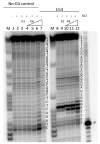Antiviral Activity of the G-Quadruplex Ligand TMPyP4 against Herpes Simplex Virus-1
- PMID: 33525505
- PMCID: PMC7911665
- DOI: 10.3390/v13020196
Antiviral Activity of the G-Quadruplex Ligand TMPyP4 against Herpes Simplex Virus-1
Abstract
The herpes simplex virus 1 (HSV-1) genome is extremely rich in guanine tracts that fold into G-quadruplexes (G4s), nucleic acid secondary structures implicated in key biological functions. Viral G4s were visualized in HSV-1 infected cells, with massive virus cycle-dependent G4-formation peaking during viral DNA replication. Small molecules that specifically interact with G4s have been shown to inhibit HSV-1 DNA replication. We here investigated the antiviral activity of TMPyP4, a porphyrin known to interact with G4s. The analogue TMPyP2, with lower G4 affinity, was used as control. We showed by biophysical analysis that TMPyP4 interacts with HSV-1 G4s, and inhibits polymerase progression in vitro; in infected cells, it displayed good antiviral activity which, however, was independent of inhibition of virus DNA replication or entry. At low TMPyP4 concentration, the virus released by the cells was almost null, while inside the cell virus amounts were at control levels. TEM analysis showed that virus particles were trapped inside cytoplasmatic vesicles, which could not be ascribed to autophagy, as proven by RT-qPCR, western blot, and immunofluorescence analysis. Our data indicate a unique mechanism of action of TMPyP4 against HSV-1, and suggest the unprecedented involvement of currently unknown G4s in viral or antiviral cellular defense pathways.
Keywords: G-quadruplex; G-quadruplex ligands; HSV-1; TMPyP2; TMPyP4; antiviral activity.
Conflict of interest statement
The authors declare no conflict of interest. The funders had no role in the design of the study; in the collection, analyses, or interpretation of data; in the writing of the manuscript, or in the decision to publish the results.
Figures










References
Publication types
MeSH terms
Substances
LinkOut - more resources
Full Text Sources
Other Literature Sources

